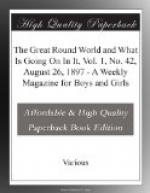This price is $300 per ton.
Congress had a long discussion about the matter, and decided that this was a fair and proper price to pay, and instructed the Secretary of the Navy to buy it for this sum.
The Secretary had his doubts about the possibility of doing as he was required, because he knew that the iron and steel manufacturers asked a much higher price.
He, however, did as Congress desired, with the result that the Carnegie Company refused point-blank, saying they could not possibly manufacture it for that price. Several other firms also declined, and finally, giving up all hope of placing the contracts, the Secretary suggested that the Government should make its own armor-plate.
Agreeably to this suggestion, a board has been formed to look into the matter, and see whether it is possible for the Government to enter into this business with profit to itself.
While some people declare that it will cost the Government twice as much to manufacture the armor, others think that it can be made for considerably less than the companies ask.
The history of this affair is very interesting.
About 1885, Mr. Whitney, who was then Secretary of the Navy, induced a private company, the Bethlehem Iron Works, to build the first American armor plant, by making a number of contracts with them which would keep them busy furnishing armor for battleships for several years.
The price then fixed was $580 per ton, and the armor to be supplied was what is known as steel armor.
Before the first contract could be filled, the next Secretary, Mr. Tracy, had his attention called to some new kinds of armor that were being introduced.
One kind was being made by an English firm, and another by a French company.
The English plan was to make what is called compound armor. This was hard steel welded on to a back of softer metal, the idea being that the soft back would act as a sort of cushion, and save the front part of the plate from being cracked by the blows of the shot.
The French system was to make a mixture of steel and nickel. They claimed that the nickel alloy would give greater strength to the plate.
Secretary Tracy was so anxious that we should have the best possible armor for our battleships that he ordered a plate from both companies, and sent them to the Naval Academy at Annapolis to be tested.
The big guns were tried on first one and then the other; the English armor cracked in four pieces, but on the nickel steel the shot were shattered into fragments.
Congress immediately voted that the new battleships should be supplied with nickel-steel armor, and an appropriation was made for this purpose.
Before the new contract could be carried out, President Harrison learned that a man named Harvey had invented a process for hardening the surface of the steel used in making tools. This process was found to be so excellent that it revolutionized the making of tools, which were thereafter made from the hardened or “Harveyized steel.”




